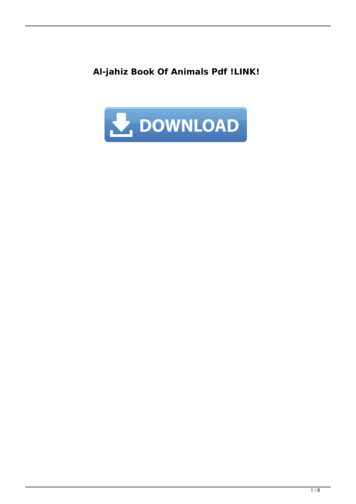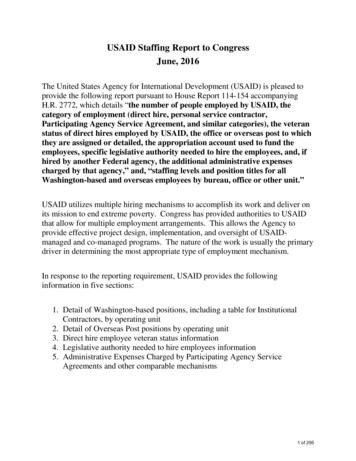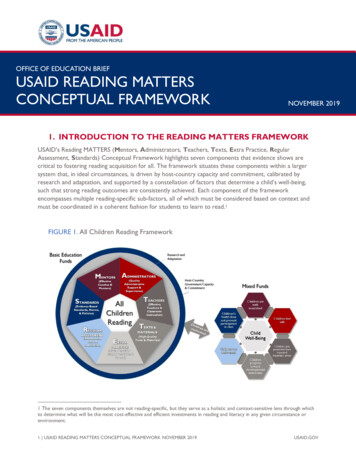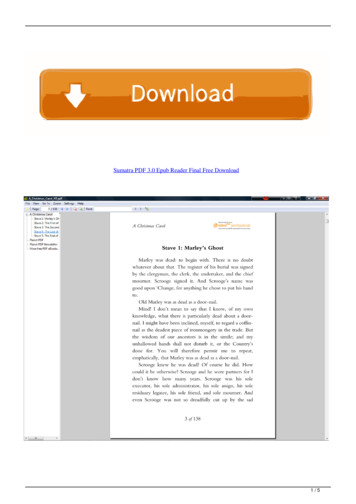
Transcription
llocation and TenureInstruments onForest LandsA Source Book
Published in July 2004 by:The Philippine Environmental Governance ProgramDepartment of Environment and Natural Resources, Manilawith technical and production support from:The Philippine Environmental Governance ProjectProduced by the Department of Environment and Natural Resources-United States Agency for International Development’s(DENR-USAID) Philippine Environment Governance (EcoGov) Project through the assistance of the USAID under ContractNumber PCE-1-00-99-00002-00. The views expressed and opinions contained in this publication are those of the authors and arenot intended as statements of policy of USAID or the authors’ parent organization.
ContentsForeword . iiiList of Acronyms . vI.Introduction . 1II.Constitutional Bases for the Exploration, Developmentand Utilization of Forest Resources . 2III.Authority/Source of Power in Allocation of Forest Lands . 3IV.Agencies Tasked with Forest and Natural Resources Management . 7V.Allocation/Tenure Instruments . 10VI.Licenses and Permits Issued for the Utilization of Forest Resources. 18VII.Agreements and Permits Involving Forest Resources in Private Lands . 21AnnexesAllocation and Tenure Instruments on Forest Lands: A Source Booki
iiAllocation and Tenure Instruments on Forest Lands: A Source Book
FOREWORDOver the last 30 years, the Department of Environment and Natural Resources (DENR)has developed and issued many types of tenure and allocation instruments and permitsregarding the use of forests and forest lands. These instruments were in response to theincreasing need to address property rights to effectively protect and manage forests andforest lands. Accordingly, DENR has either caused the issuance or directly issued allocation ortenure instruments to various stakeholders such as the private sector, government agencies,communities and others.Through time, however, modifications to these instruments and procedures were made, leavingmany of the intended beneficiaries unaware of the changes; while those who may have heard ofthem do not really know what these changes are for and how they would affect them. In manycases, information on various tenure and allocation instruments—may they be old, modified ornew—in public forests and forest lands had been fragmented and scanty making it difficult evenfor the DENR personnel at the community level to share and disseminate complete information todifferent stakeholders.As the DENR pushes for a stronger partnership with local governments, people’s organizations(POs), private sector and other government agencies in the protection and management of thecountry’s forests and forest lands, there is a need for DENR personnel, especially those in thefield, to re-acquaint themselves with the different allocation and tenure instruments. A ready materialsuch as this Source Book would be a great help in making them more responsive to the localneeds.This Allocation and Tenure Instruments on Forest Lands: A Source Book is a fine example ofwhat is needed in the field. It highlights the features of several instruments, talks about licensesand permits, provides sample instruments and is even accompanied by a compact disc thatcontains the sample instruments and most of the laws and policies discussed in the SourceBook.While this publication can be accessed by the general public, it would be extremely useful forDENR field personnel in serving the information needs of the local governments, POs, the privatesector, other organized groups or entities and concerned individuals interested in working withthe DENR in managing the country’s forests and forest lands.This Source Book has been a product of the close collaboration between the DENR and thePhilippine Environmental Governance Project, which is assisted by the United States Agency forInternational Development.ELISEA S. GOZUNSecretaryAllocation and Tenure Instruments on Forest Lands: A Source Bookiii
ivAllocation and Tenure Instruments on Forest Lands: A Source Book
LIST OF ACRONYMSA&DAWPBFDCADCCADC-CBFMA-CALCCALC-CBFMA nable and DisposableAnnual Work PlanBureau of Forest DevelopmentCertificate of Ancestral Domain ClaimCertificate of Ancestral Domain Claim-Community Based Forest ManagementAgreementCertificate of Ancestral Land ClaimCertificate of Ancestral Land Claim- Community Based Forest ManagementAgreementCommunity Based Forest ManagementCommunity Based Forest Management AgreementComprehensive Development and Management PlanCommunity Environment and Natural Resources OfficerCoastal Environment ProgramCommunity Forestry ProgramConvention on International Trade on Endangered SpeciesCertificate of Land Ownership AgreementCertificate of Non-CoverageCommercial Research AgreementCommunity Resource Management FrameworkCertificate of Stewardship ContractCommunity Special Task Force on Ancestral LandsDevelopment Alternatives, Inc.Department Administrative OrderDepartment of Environment and Natural ResourcesDepartment of the Interior and Local GovernmentDepartment of Trade and IndustryEnvironment Compliance CertificatePhilippine Environmental Governance ProjectEnvironmental Impact StatementEnvironmental Management BureauEnvironment and Natural Resources CouncilExecutive OrderForestry Administrative OrderForest Land Grazing Management AgreementForest Land Management AgreementForest Land Management ProgramForest Land Use PlanFree and Prior Informed ConsentForestry Sector ProjectInter-Agency Committee on Biological and Genetic ResourcesIndigenous Cultural Communities/Indigenous PeoplesInitial Environmental ExaminationIntegrated Forest Management AgreementIndustrial Forest PlantationIntegrated Protected Areas FundAllocation and Tenure Instruments on Forest Lands: A Source Bookv
UNCBDUPUPLBUSAIDWCPBWFPWRPvi-Integrated Rainforest Management ProjectImplementing Rules and RegulationsIntegrated Social Forestry ProgramJoint Memorandum CircularJoint OrdersLog Control and Monitoring SystemsLocal Government UnitLow Income Upland Communities ProjectLetter of InstructionMemorandum CircularMunicipal Environment and Natural Resources OfficerMulti-Sectoral Forest Protection CommitteeMemorandum of AgreementMemorandum of UnderstandingNational Commission on Indigenous PeoplesNational Integrated Protected Areas SystemOrdinary Minor Forest Products LicenseOperations PlanProtected AreaProtected Area Community-Based Resource Management AgreementProtected Area Management BoardProtected Area SuperintendentProtected Areas and Wildlife BureauPalawan Council for Sustainable DevelopmentPresidential DecreeProvincial Environment and Natural Resources OfficerPrivate Forest Development AgreementPrivate Land Timber PermitProject Management OfficeProvincial Planning and Development OfficerPeople’s OrganizationRepublic ActRattan Cutting ContractRegional Executive DirectorRegional Resources Management ProjectSteering CommitteeStrategic Environmental PlanSocialized Industrial Forest Management AgreementSocialized Industrial Forest PlantationSpecial Private Land Timber PermitTimber License AgreementUpland Development ProgramUnited Nations Convention on Biological DiversityUniversity of the PhilippinesUniversity of the Philippines - Los BañosUnited States Agency for International DevelopmentWildlife Collector’s Permit for BreedingWildlife Farm PermitWood Recovery PermitAllocation and Tenure Instruments on Forest Lands: A Source Book
Allocation and Tenure Instruments on Forest Lands:A Source BookI. INTRODUCTIONThis Source Book, prepared by the Philippine Environmental Governance (EcoGov) Projectin collaboration with the Department of Environment and Natural Resources (DENR), isintended to serve as a reference material to help DENR field personnel in guidingcommunities, investors, local government units (LGUs), private persons and other organizationsand individuals desiring to apply for tenure instruments on forest lands.It covers all existing tenure and allocation agreements for the management and use of forestresources in forest lands. Agreements generally refer to long-term tenure instruments in forestlands with right of occupation. This material also features information on permits and licenses,which are generally short-term instruments where the holder is given the privilege to conductdevelopmental activities within the forest lands but without right of occupation.Each agreement and instrument is briefly described. Sample specimen of the various permitsand instruments are provided so that the reader would know how they look like.This Source Book hopes to elevate the level of transparency in the system of allocating tenureand access rights to upland resources in the Philippines by facilitating access to this information,especially by the local stakeholders including local governments. It improves accountability asthe public is properly guided as to the functions and responsibilities of concerned agencies andoffices and tenure holders. Also, it encourages participation as the issuance of the instrumentprovides for participatory decision-making among the DENR, LGUs and other stakeholders.Having more knowledge about tenures and permits will help DENR field personnel become moreresponsive, efficient and effective in the delivery of this service. It will also help enhance theawareness of LGUs and their constituents on opportunities for developing resources in forestlands within their jurisdictions .The details of each instrument presented are found in the relevant laws and regulations containedin the accompanying compact disc. The reader is advised to refer to the complete version of thelaws or rules to gain a better appreciation of the process, requirements and regulations involved.Assistance may also be sought from the agency or office responsible for issuing the instrument.Allocation and Tenure Instruments on Forest Lands: A Source Book1
II. CONSTITUTIONAL BASES FOR THE EXPLORATION, DEVELOPMENTAND UTILIZATION OF FOREST RESOURCESzThe use and disposition of forest resources in the country are governed by twoConstitutional provisions. These are as follows:All natural resources are owned by the State. This is the so called Regalian Doctrine.The pertinent provision in the Constitution reads:“All lands of the public domain, water, minerals, coal, petroleum and other mineral oils, allforces of potential energy, fisheries, forests or timber, wildlife, flora and fauna, and other naturalresources are owned by the State. The exploration, development and utilization of naturalresources shall be under the full control of the State.” (Article XII, Sec. 2; 1987 PhilippineConstitution)zThere are four modes by which natural resources may be explored, developed andutilized.These are:a)b)c)d)directly by the State; orthrough co-production;joint venture;or production sharing agreements.“The exploration, development, and utilization of natural resources shall be under the fullcontrol of the State. The State may directly undertake such activities, or it may enter into coproduction, joint venture, or production sharing agreements with Filipino citizens, or corporationsor associations at least 60% of whose capital is owned by such citizens.” (Article XII, Sec. 2;1987 Philippine Constitution)2Allocation and Tenure Instruments on Forest Lands: A Source Book
III. AUTHORITY/SOURCE OF POWER IN ALLOCATION OF FOREST LANDSIn the Philippines, the power to allocate lands is vested in the following authorities:A. CongressBy its lawmaking powers, Congress can enact laws to establish certain areas as forest landsand national parks. In fact, Article XII, Sec. 4 states that:“Congress shall as soon as possible, determine by law the specific limits of forest lands andnational parks, marking clearly their boundaries on the ground. Thereafter, such forest landsand national parks shall be conserved and may not be increased nor diminished, except bylaw.”Under Republic Act (RA) 7586 or the National Integrated Protected Areas System (NIPAS)Act, the establishment of protected areas has to be through an act of Congress.RA 6967, vesting jurisdiction of Mt. Makiling to the University of the Philippines Los Baños(UPLB), is an example of using the Congressional power in the allocation of forest lands andnational parks.B. President of the PhilippinesThis takes the form of Presidential issuances or proclamations, such as declaring certainforest areas and forest lands as forest reserves or military/civil/mineral reservations.C. DENRThe DENR is the primary government agency tasked with natural resources and forestmanagement. This is contained in Executive Order (EO) No. 192, Series of 1987. Section 4of the EO states:“The Department (DENR) shall be the primary government agency responsible for theconservation, management, development, and proper use of the country’s environment andnatural resources, specifically forest and grazing lands, mineral resources, including those inreservation and watershed areas, and lands of the public domain, as well as the licensing andregulation of all natural resources as may be provided by law, in order to ensure equitablesharing of the benefits derived therefrom for the welfare of the present and future generationsof Filipinos.”Allocation and Tenure Instruments on Forest Lands: A Source Book3
D. Local Government UnitsRA 7160, otherwise known as the Local Government Code of 1991, states that LGUs shallshare with the national government (DENR) the responsibility of maintaining ecological balancewithin their respective jurisdictions. The Local Government Code has further devolved certainforest management functions to the LGUs pursuant to national policies and subject tosupervision, control and review of the DENR.When the forestry functions, as mandated under RA 7160, shall have been devolved to localgovernments, the LGUs will likewise be exercising allocation functions over devolved areas,subject to sustainable forest management plans prepared in coordination with the DENR,and jointly monitored by these agencies.E. DENR and LGU through Joint Orders/Joint Memoranda of AgreementPursuant to the Local Government Code, the DENR and the Department of the Interior andLocal Government (DILG) have come up with Joint Memorandum Circulars (JMC), namely,DENR-DILG JMC 98-01 and DENR-DILG JMC 2003-01 setting the mechanism for thedevolution and partnership. Under these JMCs, the DENR and the LGUs can come up withJoint Orders or Memoranda of Agreement (MOA) for the co-management of certain forestareas.JMC 2003-01 reiterates LGU participation in the issuance of tenure instruments and permits.It states that before DENR can issue tenure instruments and permits, the application mustfirst be submitted for comments to the concerned LGUs which shall have 15 days to act onthe application. If the tenure instrument or permit is issued without the LGU’s comments,activities in the forest area shall be suspended until such time that the LGU’s comments arereceived.F. National Commission on Indigenous Peoples (NCIP)Under RA 8371, otherwise known as the Indigenous People’s Rights Act of 1997, indigenouspeoples can now obtain titles to their ancestral domains and lands through the Certificate ofAncestral Domain Title (CADT) and Certificate of Ancestral Land Title (CALT). Ancestral domainsand lands are all areas generally belonging to the Indigenous Cultural Communities/IndigenousPeoples (ICCs/IPs), owned, occupied or possessed by themselves or through their ancestors,communally or individually since time immemorial.Lands within ancestral domains shall include, but not limited to: ancestral lands, forests,pasture lands, residential lands, agricultural lands, hunting grounds, worship areas, lands nolonger occupied by the ICCs/IPs but from which they traditionally had access for theirsubsistence and traditional activities, home ranges of ICCs/IPs who are still nomadic andshifting cultivators, and other lands individually owned, whether alienable and disposable orotherwise.4Allocation and Tenure Instruments on Forest Lands: A Source Book
The agency, which is tasked to carry out the policies set forth in the law, is the NationalCommission on Indigenous Peoples (NCIP). When CADTs or CALTs are issued, themanagement of the areas should take into consideration environmental concerns. The pertinentprovisions of the law read:“Section 38. National Commission on Indigenous Cultural Communities/IndigenousPeoples (NCIP) – to carry out the policies herein set forth, there shall be created theNational Commission on ICCs / IPs (NCIP), which shall be the primary government agencyresponsible for the formulation and implementation of policies, plans and programs topromote and protect the rights and well-being of the ICCs/IPs and the recognition of theirancestral domains as well as their rights thereto.”“Sec. 44. To accomplish its mandate, the NCIP shall have the following powers, jurisdictionand functions: xxx(e) To issue certificate of ancestral land / domain title. xxx”“Sec. 57. Natural Resources within Ancestral Domain – the ICCs/IPs shall have priorityrights in the harvesting, extraction, development, exploitation of any natural resourceswithin the ancestral domains. A non-member of the ICCs/IPs concerned may be allowedto take part in the development and utilization of the natural resources for a period of notexceeding twenty-five (25) years renewable for not more twenty-five (25) years: Provided,that a formal written agreement is entered into with the ICCs/IPs concerned or that thecommunity, pursuant to its own decision making process, has agreed to allow suchoperation: Provided, finally, that the NCIP may exercise visitorial powers and takeappropriate action to safeguard the rights of the ICCs/IPs under the same contract.”“Sec. 58. Environmental Considerations. Ancestral domains or portions thereof, whichare found to be necessary for critical watersheds, mangroves, wildlife sanctuaries,wilderness, protected areas, forest cover, or reforestation as determined by appropriateagencies with the full participation of the ICCs/IPs concerned shall be maintained, managedand developed for such purposes. The ICCs/IPs concerned shall be given the responsibilityto maintain, develop, protect, and conserve such areas with the full and effective assistanceof government agencies. Should the ICCs/IPs decide to transfer the responsibility overthe areas, said decision must be made in writing. The consent of the ICCs/IPs should bearrived at in accordance with its customary laws without prejudice to the basic requirementsof existing laws on free and prior informed consent: Provided, the transfer shall be temporaryand will ultimately revert to the ICCs/IPs in accordance with a program for technologytransfer: Provided, further, that no ICCs/IPs shall be displaced or relocated for the purposeenumerated under this section without the written consent of the specific persons authorizedto give consent.”Allocation and Tenure Instruments on Forest Lands: A Source Book5
In summary:Authority/Source of Power in the Land Use Allocation of Forest Lands6AuthorityUse RightsLegislationExecutive Orders/ Presidential ProclamationsDENR Administrative OrdersJoint Orders/ Memoranda of AgreementLGU OrdinancesNCIPForest Lands, Protected Areas, ReservationsProtected Areas, ReservationTenure InstrumentsCo-ManagementIn devolved areasIn forest areas which are consideredancestral domains and ancestral lands(subject to environmental considerations)Allocation and Tenure Instruments on Forest Lands: A Source Book
IV. AGENCIES TASKED WITH FOREST AND NATURAL RESOURCES MANAGEMENTThe following agencies are given the responsibility to manage the Philippine forest andnatural resources:A. Department of Environment and Natural Resources (DENR)As mentioned earlier, the DENR is the primary government agency responsible for theconservation, management, development, and proper use of the country’s environment andnatural resources.B. Local GovernmentsThe Local Government Code of 1991 gives LGUs the mandate and responsibility for managingand maintaining the ecological balance within their territories. The pertinent provision readsas follows:“Local Government Units shall share with the national government the responsibility inthe management and maintenance of ecological balance within their territorial jurisdiction,subject to the provisions of this Code and national policies.”[Sec. 3 (i), RA 7160]As mentioned above, certain forest management functions have been devolved to localgovernments under the Code. The following are the devolved functions:Table 1. List of Functions Devolved to Local Government UnitsProvinces [Sec. 17, (3) (iii)]Municipalities [Sec. 17, (2) (ii)]Forest Protection incommunity forestry projectsCommunity-based forestryprojects which includeintegrated social forestryprograms and similar projectsManagement and control ofcommunal forests with an areanot exceeding 50 squarekilometersEstablishment of tree parks,greenbelts and similardevelopment projectsPollution control lawSmall scale mining lawCities [Sec. 17, (4)]All forest managementfunctions and activities thathave been devolved toprovinces and municipalitiesMini-hydro electric projectsfor local purposesOther laws on the protectionof the environmentAllocation and Tenure Instruments on Forest Lands: A Source Book7
C. Palawan Council for Sustainable Development (PCSD) with Respect to the Provinceof PalawanTo ensure the sustainable development of Palawan’s natural resources, RA 7611 (1992) orthe Strategic Environmental Plan for Palawan Act was passed. Sec. 16 of said law states:“Sec. 16. Palawan Council for Sustainable Development- The governance, implementationand policy direction of the Strategic Environmental Plan shall be exercised by the hereincreated Palawan Council for Sustainable Development (PCSD), hereinafter referred to asthe Council which shall be under the Office of the President. It shall be composed of themembers of the House of Representatives representing the Province of Palawan, theDeputy Director General of the National Economic and Development Authority, theUndersecretary of the Department of Environment and Natural Resources, theUndersecretary for Special Concerns of the Department of Agriculture, the Governor ofPalawan, the Mayor of Puerto Princesa City, the President of the Mayors’ League ofPalawan, the President of the Provincial Chapter of the Liga ng mga Barangay, theExecutive Director of the Palawan Council for Sustainable Development Staff as providedfor in Section 20 of this Act, and such other members, from the public or private sectorsas the majority of the Council may deem necessary ”D. UP Los Baños with Respect to Mt. MakilingThe management of Mt. Makiling in the province of Laguna is vested in UP Los Baños byvirtue of RA 6967. The pertinent provisions read:“Sec. 1. The entire forest reserve at Mt. Makiling in Laguna, ceded, transferred andconveyed to the University of the Philippines pursuant to RA 3523 shall be administeredand conserved primarily as a training laboratory for the advancement of scientific andtechnical knowledge particularly in the preservation, conservation and development ofour forest, flora and fauna and natural resources.”“Sec. 2. The exclusive jurisdiction, administration and complete control of said forestreserve are hereby vested in the University of the Philippines in Los Baños.”E. Department of EnergyThe Department of Energy, through the National Power Corporation, has jurisdiction oversome watershed areas in the country. These watershed areas are Tiwi Geothermal, Tongonanand Palimpinon.Sec. 2 of PD 1515 as amended by PD 1749 reads:“Sec. 2. In relation to Sec. 1, the Ministry of Energy through the National Power Corporationshall be responsible for the management, protection, development and rehabilitation ofthe aforementioned watershed areas, x x x Provided, that said areas, pursuant to LOI 917shall not be the subject of exploitation of whatever nature.”8Allocation and Tenure Instruments on Forest Lands: A Source Book
F. Other AgenciesThere are also forest areas and reservations being managed by other agencies pursuant toother laws, proclamations, executive orders and joint agreements. One example is the MOAbetween the DENR and the Philippine National Oil Company, a government corporation, whichhas made a commitment to help protect and develop certain watershed areas for sustenanceof geothermal energy projects and has been tasked, among others, to rehabilitate all areaswithin its jurisdiction affected by geothermal operations. Other examples include civil andmilitary reservations, such as the Higaonon Civil Reservation in Agusan del Sur and FortMagsaysay in Nueva Ecija.Allocation and Tenure Instruments on Forest Lands: A Source Book9
V. ALLOCATION/TENURE INSTRUMENTSA. In Production Forest LandsProduction forest lands are those where sustainable timber extraction is allowed.The existing allocation and tenure instruments related to the access and utilization of forestresources in production forest lands are categorized in this Source Book into three:1) Those involving communities,2) Those involving the private sector and3) Those involving LGUs.The sub-categories of various instruments under these broad classifications are as follows:1. Involving CommunitiesThe tenure instruments developed for communities are:zCommunity Based Forest Management Agreement (CBFMA)Community-Based Forest Management (CBFM) is thenational strategy for sustainable development of thecountry’s forest resources. This is contained in EONo. 263 Series of 1995. The rules and regulations forthe implementation of CBFM Program are coveredunder DENR Administrative Order (DAO) No. 96-29and DAO 2003-11.CBFMA is the primary tenure instrument issued underthe CBFM Program.Under DENR DAO 96-29, theCBFM program has integratedand unified all people-orientedforestry programs of thegovernment including the ForestLand Management Program(FLMP), Community ForestryProgram (CFP), Integrated SocialForestry Program (ISFP), LowIncome Upland CommunitiesProject (LIUCP), UplandDevelopment Program (UDP),Regional Resources ManagementProject (RRMP), IntegratedRainforest Management Project(IRMP), Forestry Sector Project(FSP), Coastal EnvironmentProgram (CEP) and Recognitionof Ancestral Domains/Claims.A CBFMA is a production sharing agreement enteredinto between a community and the government for thepurpose of developing, utilizing, managing andconserving a specific portion of the forest lands (whichinclude mangrove areas), consistent with the principlesof sustainable development and pursuant to aCommunity Resource Management Framework(CRMF). The CBFMA has a duration of 25 yearsrenewable for another 25 years. All CBFMAs shall beendorsed individually or jointly by the concerned legislative councils of the barangay,municipal, and provincial LGUs, depending on the jurisdiction and coverage of thearea. People’s organizations (POs) can opt to enter into business contracts with private10Allocation and Tenure Instruments on Forest Lands: A Source Book
investors to help them develop the awarded area. The DENR, as part of theircommitments under the CBFMA, can help facilitate this linkage and review the contractto make sure that the POs are not exploited.The sample instrument of the CBFMA is attached as Annex “A”. The legal bases for itsissuance include DENR DAOs 96-29 and 98-45.zCertificates of Ancestral Domain Title (CADT)/Certificates of Ancestral LandTitle (CALT)Under the Indigenous People’s Rights Act of 1997, ICCs/IPs have the right to apply forthe issuance of a CADT or a CALT. A CADT pertains to a title issued over ancestraldomains; a CALT pertains to a title issued covering individually owned ancestral lands.(See Certificate of Ancestral Domain Claim/Certificate of Ancestral Land Claim, Letter“d” of next section; also, see NCIP, page 4).Tenure Instruments Issued to Communities Prior to the CBFM ProgramThere were various tenure instruments that the DENR used to issue to communities beforethe implementation of the CBFM Program. Some of these still exist as their duration is for 25years; some have been converted to CBFMAs.Some of these are briefly discussed below.a) Forest Land Management Agreement (FLMA)The government issued FLMAs through the FLMP, which was governed by DENRDAO 23, Series of 1993.The FLMA replaced the former short-term reforestation contracts as the principal modefor accomplishing the reforestation objectives of the government in collaboration withforest occupants and residents of upland communities.The program granted participants the sole and exclusive right to occupy, develop andmanage specified areas of forest lands, subject to repayable financial assistance fromDENR and to harvest, sell and utilize products grown on the land.b) Community Forestry Management Agreement (CFMA)The issuance of the CFMA was a feature of the Community Forestry Program (CFP)of the DENR which granted rights to organized communities to manage, develop andutilize forest resources on a sustainable b
zThere are four modes by which natural resources may be explored, developed and utilized. These are: a) directly by the State; or b) through co-production; c) joint venture; d) or production sharing agreements. "The exploration, development, and utilization of natural resources shall be under the full control of the State.











